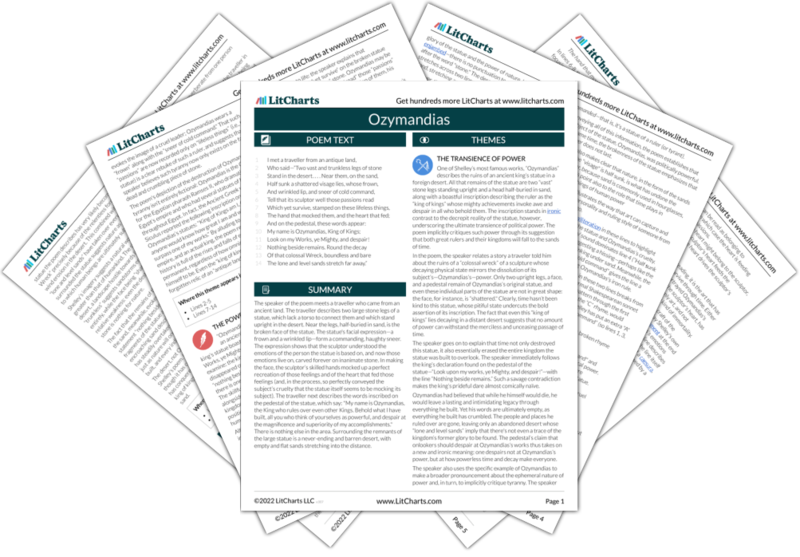
“Ozymandias” is a sonnet written by the English Romantic poet Percy Bysshe Shelley. Shelley wrote “Ozymandias” in 1817 as part of a poetry contest with a friend and had it published in The Examiner in 1818 under the pen name Glirastes. The title “Ozymandias” refers to an alternate name of the ancient Egyptian pharaoh Ramses II. In the poem, Shelley describes a crumbling statue of Ozymandias as a way to portray the transience of political power and to praise art’s ability to preserve the past. Although the poem is a 14-line sonnet, it breaks from the typical sonnet tradition in both its form and rhyme scheme, a tactic that reflects Shelley’s interest in challenging conventions, both political and poetic.
|
Get
LitCharts
|

|
The Full Text of “Ozymandias”
1I met a traveller from an antique land,
2Who said—“Two vast and trunkless legs of stone
3Stand in the desert. . . . Near them, on the sand,
4Half sunk a shattered visage lies, whose frown,
5And wrinkled lip, and sneer of cold command,
6Tell that its sculptor well those passions read
7Which yet survive, stamped on these lifeless things,
8The hand that mocked them, and the heart that fed;
9And on the pedestal, these words appear:
10My name is Ozymandias, King of Kings;
11Look on my Works, ye Mighty, and despair!
12Nothing beside remains. Round the decay
13Of that colossal Wreck, boundless and bare
14The lone and level sands stretch far away.”
The Full Text of “Ozymandias”
1I met a traveller from an antique land,
2Who said—“Two vast and trunkless legs of stone
3Stand in the desert. . . . Near them, on the sand,
4Half sunk a shattered visage lies, whose frown,
5And wrinkled lip, and sneer of cold command,
6Tell that its sculptor well those passions read
7Which yet survive, stamped on these lifeless things,
8The hand that mocked them, and the heart that fed;
9And on the pedestal, these words appear:
10My name is Ozymandias, King of Kings;
11Look on my Works, ye Mighty, and despair!
12Nothing beside remains. Round the decay
13Of that colossal Wreck, boundless and bare
14The lone and level sands stretch far away.”
-
“Ozymandias” Summary
-
-
“Ozymandias” Themes
-
The Transience of Power
- See where this theme is active in the poem.
-
The Power of Art
- See where this theme is active in the poem.
-
Man Versus Nature
- See where this theme is active in the poem.
-
-
Line-by-Line Explanation & Analysis of “Ozymandias”
-
Lines 1-2
I met a traveller from an antique land,
Who said -
Lines 2-3
—“Two vast and trunkless legs of stone
Stand in the desert. . . . Near them, on the sand, -
Lines 4-5
Half sunk a shattered visage lies, whose frown,
And wrinkled lip, and sneer of cold command, -
Lines 6-8
Tell that its sculptor well those passions read
Which yet survive, stamped on these lifeless things,
The hand that mocked them, and the heart that fed; -
Lines 9-11
And on the pedestal, these words appear:
My name is Ozymandias, King of Kings;
Look on my Works, ye Mighty, and despair! -
Lines 12-14
Nothing beside remains. Round the decay
Of that colossal Wreck, boundless and bare
The lone and level sands stretch far away.”
-
-
“Ozymandias” Symbols
-
Sand
- See where this symbol appears in the poem.
-
The Statue
- See where this symbol appears in the poem.
-
-
“Ozymandias” Poetic Devices & Figurative Language
-
Enjambment
- See where this poetic device appears in the poem.
-
Caesura
- See where this poetic device appears in the poem.
-
Alliteration
- See where this poetic device appears in the poem.
-
Irony
- See where this poetic device appears in the poem.
-
-
“Ozymandias” Vocabulary
Select any word below to get its definition in the context of the poem. The words are listed in the order in which they appear in the poem.
- Antique
- Trunkless
- Visage
- Passions
- Stamped
- Mocked
- Pedestal
- Ozymandias
- Remains
-
- See where this vocabulary word appears in the poem.
-
Form, Meter, & Rhyme Scheme of “Ozymandias”
-
Form
-
Meter
-
Rhyme Scheme
-
-
“Ozymandias” Speaker
-
-
“Ozymandias” Setting
-
-
Literary and Historical Context of “Ozymandias”
-
-
More “Ozymandias” Resources
-
External Resources
-
British Library's "Introduction to Ozymandias" — The British Library has a short introduction to "Ozymandias" that includes excerpts of potential sources for the poem, historical information about Ramses II (Ozymandias), as well as details about Shelley's radical politics.
-
Draft of "Ozymandias" — The Bodleian Library at Oxford University digitized and transcribed an early draft of "Ozymandias" from 1817 and made it available online.
-
"Ozymandias": Original Printing — Shelley first published "Ozymandias" in The Examiner in 1818, under the name "Glirastes." This is a scan of the first edition printing.
-
British Museum: The Younger Memnon — This website shows the statue of Ramses II (Ozymandias), the discovery of which may have inspired Shelley's poem.
-
Breaking Bad and Ozymandias — The tv show Breaking Bad featured the poem "Ozymandias" in a trailer for the final season. The BBC explains why and embeds the trailer in the webpage.
-
-
LitCharts on Other Poems by Percy Bysshe Shelley
-
















